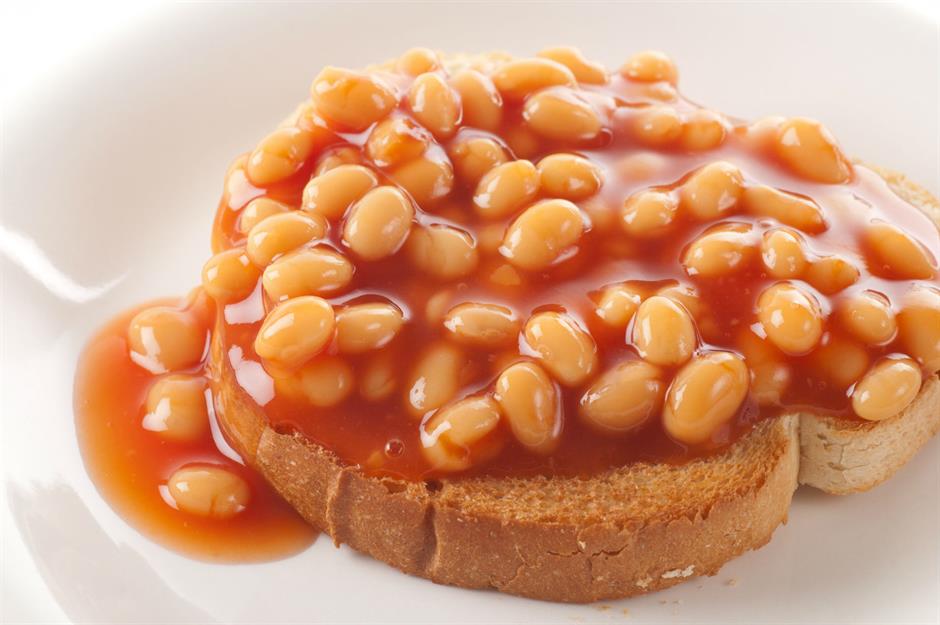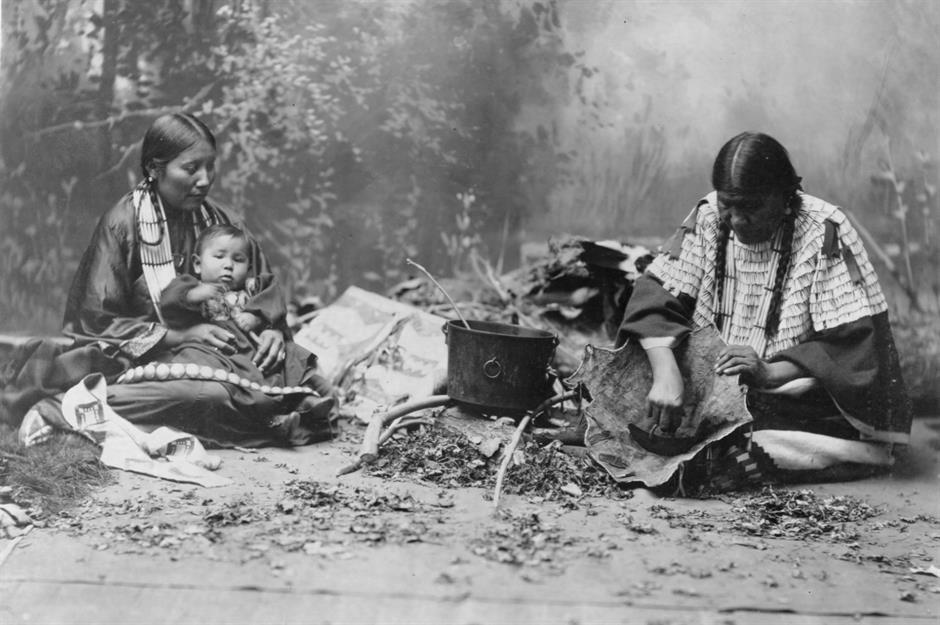The secret history of baked beans
A canned history
Baked beans are a store-cupboard staple and a byword for easy, economical meals. You might prefer them spooned on top of jacket potatoes, with sausages, or tipped on top of toast. You might even enjoy them cold, straight from the tin. Whatever your preferred way to devour baked beans (or whether you like them at all), the seemingly simple side dish packs in a surprising amount of history. Here’s the fascinating story behind the humble baked bean, from its origins to its journey to the tin.
An indigenous American staple
It’s tricky to pinpoint the exact genesis of the baked bean, though the most widely-held theory is that the modern canned variety has its origins in Native American cuisine, specifically in dishes cooked by indigenous peoples in the northeast and belonging to tribes including Iroquois, Narragansett and Penobscot. The beans were baked in earthenware pots with maple syrup and, sometimes, venison meat and even bear fat – creating a dish prized for its high protein, calorie and fat content.
Or did they come from France?
Another theory is that they evolved from cassoulet, a slow-cooked stew from southern France. It shares similarities with the original bean dish, containing meat and infused with a rich, satisfying stickiness, and English colonists may have brought elements of this stew to America. But cassoulet – named for the pot it’s traditionally cooked in – is made with Tarbais beans (flageolet or cannelloni beans are often used, too), whereas baked beans are made with beans native to the Americas.
Global appeal
Places around the world have variations of baked, stewed and simmered beans that predate the beloved tins. There’s the cassoulet of southern France, fagioli al fiasco – a simple bean stew traditionally cooked overnight in a flask – in Tuscany, Italy, and feijoada (black beans and meat, pictured) in Portugal and its former colonies, including Brazil. White beans and bacon was also a staple in medieval England.
In the navy
Baked beans as we know them, though, are made with the same type of beans as those used in the indigenous American recipes: a type of haricot beans known as navy beans. These are native to South America and weren’t introduced to Europe until the 16th century. Cassoulet, on the other hand, is widely believed to date back to the medieval period. So, while the dishes share plenty of delicious similarities, the French connection is largely dismissed.
Beans for breakfast
Puritan Christian pilgrims, arriving on the east coast of America from Europe from the 17th century, learned the indigenous recipes – and baked beans began their journey to becoming a convenience food. As their religion forbade cooking on the sabbath, pilgrims cooked the beans as a Saturday supper, kept them warm in a wood-fired oven and ate for breakfast after church on Sundays.
A stovetop staple
The ‘baked’ part may have stayed in the name, but many modern versions of the dish were not baked at all: they were cooked over fire instead of underground. The typical New England take was to simmer the beans into a stew with cubes of meat and different spices. They were still known as ‘baked beans’, however – perhaps because the alliteration is so catchy.
Chopping and changing
The recipe was adapted throughout New England states and cities as different immigrant communities put their spin on baked beans, weaving in new ingredients and flavours. In Maine, for example, so-called ‘bean-hole beans’ were baked in cast-iron pots buried in the ground (a method used by indigenous Penobscot people). They often used yellow eye beans, which are still widely used for traditional Maine baked beans today. Vermont baked beans use maple syrup, following indigenous traditions.
Boston in a bowl
The New England city most associated with the story of beans is Boston, Massachusetts, or ‘Beantown’. Boston baked beans are made with molasses for an especially rich, caramel-sweet dish, along with salt pork, black pepper and, sometimes, onion. They were often slow-cooked to form a crust (arguably the best bit). There’s no definitive history of these Boston baked beans, but it’s been suggested that – as Boston was an epicentre for rum production – the byproduct of molasses was plentiful.
The great molasses disaster
The ubiquity of molasses in Boston quite literally spilled over in January 1919 when a huge storage container ruptured, sending gallons of the sticky stuff flooding through the streets of the city’s North End neighbourhood. It crested in an enormous wave that killed 21 people, destroyed buildings and devastated everything in its path.
The first tinned beans
It’s believed baked (or not baked) beans were first canned around the 1860s. But it was the Pennsylvania-based HJ Heinz Company (founded by Henry Heinz) that started mass production of tinned baked beans, in 1895. The company – now inextricably linked to baked beans – produced the cans in Pittsburgh.
A luxury label
The beans first arrived in the UK in 1886, when Heinz sold them – along with other products including tomato ketchup – to posh London department store, Fortnum & Mason (famous for its luxury hampers). They were originally branded as a luxury item and sold for ninepence a can (the equivalent of around £2.15/$2.70 today).
Becoming a UK favourite
Sales expanded to other, less exclusive stores from the early 20th century as the beans proved a huge hit in the UK market. Salesmen – expected to be “at least six foot tall, impeccably dressed and particularly eloquent”, according to Heinz – carried flasks of heated beans to provide samples to potential customers.
An appetite for adventure
Baked beans even made it all the way to Antarctica. Crates of Heinz beans were taken on the ill-fated British Antarctic, or Terra Nova, Expedition captained by Robert Falcon Scott between 1910 and 1913. Heinz was one of several companies to provide supplies for the expedition, during which Scott and four others died. This photo of one of the team sitting on a crate while tucking into a tin became iconic – and perhaps launched the tradition of cold baked beans on camping trips.
Beans, meet toast
A hill of beans tipped onto toast is the go-to, can’t be bothered to cook anything (or don’t really have anything in the fridge) supper in the UK. It’s hard to know exactly who started making this incredibly simple dish, but Heinz claimed it was dreamt up for marketing purposes in 1927. It also makes regular appearances on breakfast plates as part of the full English (whether the beans should touch the bacon – or be there at all – is another issue altogether).
The go-to barbecue side
In the US, beans are more likely to be found on the side than as a main event. They’re especially popular in barbecue restaurants, served spooned (or in little polystyrene pots) along with ribs and tender pulled pork, or simmered in a huge pot for cookouts.
Made in Britain
Heinz beans were shipped to the UK from the Pittsburgh factory until 1928, when a Heinz factory opened in Harlesden, London to feed growing British demand. The main Wigan factory – also the world's largest baked bean factory – opened in 1959 and now produces around 383,000 tonnes of products per year.
Reinventing the classic recipe
The cans originally stuck to the US recipe, though this was a little sweet for some tastes in the UK. It was eventually modified to a tomato-based sauce without maple syrup, molasses or brown sugar. The pork was also removed due to wartime rationing, so Heinz baked beans became vegetarian.
Wartime hero
Heinz’s Harlesden factory was bombed twice during the Second World War but the company continued to produce its products. The Ministry of Food classified beans as an ‘essential food’ during the Second World War, so they were exempt from rationing (with pork now dropped from the ingredients).
Cooked in the can
Baked beans are actually cooked inside the can. The raw beans are first soaked and blanched to soften them. They are then sealed in the can with the sauce and secret spice blend and steamed to fully cook and kill any bacteria.
The Royal seal of approval
Heinz was granted the Royal Warrant in 1951 and has held it ever since, cementing its status as an honorary British icon despite its US origins. Queen Elizabeth II also visited the Wigan factory for its 50th anniversary in 2009.
A catchy slogan
The slogan ‘Beanz Meanz Heinz’ was born in 1967, and has so stuck in the minds of consumers that it was voted best advertising slogan of all time by an expert panel for Creative Review in 2012. It was conceived, like many of the best ideas, in a pub, with adman Maurice Drake aiming to make the product stand-out among cheaper competition.
Secret spices
While it’s known that Heinz uses navy beans (shipped from the US) and tomato purée, the blend of spices used is a closely guarded secret. In fact, it arrives at the Wigan factory in unlabelled bags to keep the exact contents under wraps. Only three people are said to know what the blend contains.
Discover more top-secret recipes we'd love to get our hands on
Boston’s full of beans (again)
Boston baked beans remain popular, and the city and its state still take their role in beans’ history pretty seriously. Massachusetts proclaimed the navy (haricot) bean to be its state vegetable in 1993 (although beans are technically legumes), while the ‘Beantown’ nickname has stuck throughout the centuries.
Worldwide reach
Heinz expanded its distribution in the 1990s to send cans of beans to China and Russia, with the baked beans now exported to 60 countries. The UK remains the biggest single market, though, with around two million cans of baked beans consumed per day and around three-quarters of those produced by Heinz.
A mid-Nineties price war
Heinz’s UK takeover was followed by dozens of other brands and supermarkets launching their own baked beans. A mid-Nineties price war saw cans slashed to as low as 3p, with stories of an independent grocer offering consumers 5p to buy a can.
A bit of a pickle
Branston entered the fray in 2005 with its very own baked beans, with the producer – most famous for its tangy pickle – aiming to challenge Heinz’s dominance. Its marketing campaign described the beans as “saucy” and invited the public to take part in a blind taste test, with Branston coming out on top. Heinz remains the biggest seller, though.
Beans for one
In the Noughties Heinz sought to solve the age-old problem of bean fans: how to keep the leftovers fresh in the fridge. The answer was to make individual portions, with Snap Pots launched 2007. The plastic pots are designed to be just enough for one and can be snapped open and popped in the microwave, making them suitable for work, too. Resealable Fridge Packs (pictured) followed in 2010.
Rebranding a classic
Heinz canned the ‘Heinz Baked Beans’ name in 2008, rebranding the cans with the catchier ‘Heinz Beanz’. The word ‘Beanz’ was replaced with ‘1 of your 5 a day’ in 2011, reflecting that the brand is so famous it doesn’t actually need to say what it is on the tin. The turquoise colour, in fact, is registered to the brand as a UK Trade Mark and is ‘stored’ by Pantone to ensure consistency.
Back in the US of A
Heinz has become so popular in the UK that it’s easy to forget its American origins, especially as the company’s canned beans have typically been less ubiquitous in the States. But Heinz went full circle in 2012 by adapting its recipes back to the more traditional US style (which was adapted for UK tastes decades earlier) and launching HomeStyle Beans with the sweetness and pork back once again.

